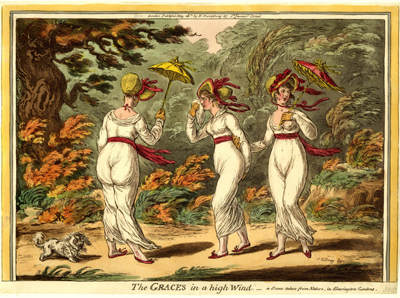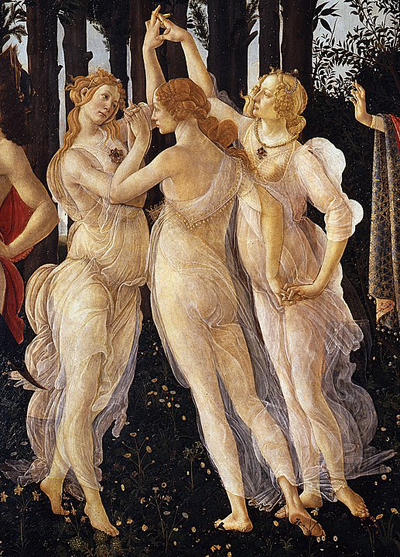The Graces in a High Wind
The Graces in a High Wind is a parody of "high art" representations of the three Charites or Graces, and a satire on the all-too-revealing women's fashion of semi-transparent white muslin dresses in the French empire style. Although Gillray takes no credit for the creation of the print (only the etching), the critique contained in it is consistent with earlier Gillray satires of women's fashion such as Ladies Dress, As It Soon Will Be (January 20, 1796), and The Fashionable Mamma, or the Convenience of Modern Dress (February 13, 1796)

© Trustees of the British Museum
In classical mythology the Graces were three beautiful godesses, daughters of Zeus and the Oceanid Euronome, and often considered part of Aphrodite's train. Hesiod identified them as Aglaea, Euphrosyne, and Thalia. Although apparently shown clothed in the earliest known depictions, by the Renaissance, they were usually portrayed as nude or mostly nude with filmy wraps such as we can see as in Botticelli's Primavera that left little to the imagination. The three goddesses were nearly always grouped together, but each one in a unique pose with at least one of them with her back to the viewer.

The Three Graces (Detail of Primavera)
[1470s or 1480s]
© WikiMedia
Gillray was no stranger to this sort of exploitation of "serious art." Ten years earlier, he had etched Venus Attired by the Graces, a broad parody of a subject addressed by Giovanni Cipriani and Francesco Bartolozzi, teachers and members of the Royal Society of Artists while Gillray was a student. Here, he follows convention by having each "Grace" facing a diffferent way, one in profile, another in 3/4 view, and one with her back (and prominent bottom) presented to the viewer. But the revelation of the female form which convention deems appropriate in "high art" seems scandalous here as the high wind exposes more of the Graces figures than they anticipated. The projected viewers' reaction is suggested by an excited dog looking up at the woman's most obvious feature and by the branches of the tree which seem to be reaching out like multiple lustful hands towards her figure. The subtitle of the print, "Taken from Nature," is, I believe, carefully chosen because it is Nature on display here only slightly hidden by the sheer and clinging dresses.
The Graces in a High Wind was probably created at roughly the same time as Grace, Fashion, and Manners which depicts the three eldest daughters of Sir William Manners. But though it may have been inspired by the Manners sisters (see my commentary on Grace, Fashion, and Manners) the faces and figures of the three women in The Graces in a High Wind are generic, and there is nothing in the print itself to suggest portraits.
Sources and Reading
- Commentary from the British Museum on The Graces in a High Wind.
- "Charites," Wikipedia
- "Primavera (Botticelli)," Wikipedia
- Thomas Wright and R.H. Evans, Historical and Descriptive Account of the Caricatures of James Gillray #578.
- Thomas Wright and Joseph Grego, The Works of James Gillray, the Caricaturist; With the History of His Life and Times, p. 370.
Comments & Corrections
NOTE: Comments and/or corrections are always appreciated. To make that easier, I have included a form below that you can use. I promise never to share any of the info provided without your express permission.